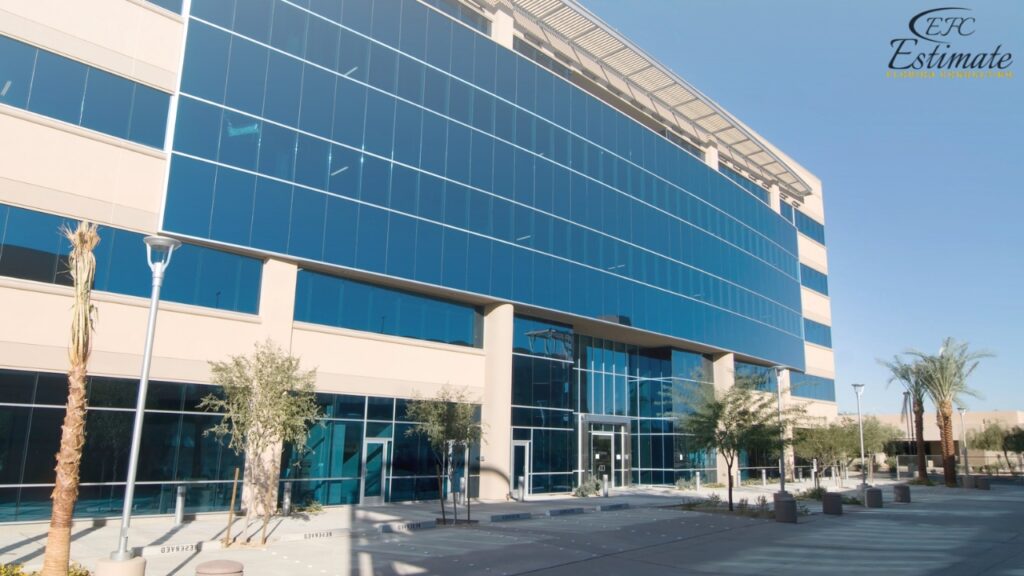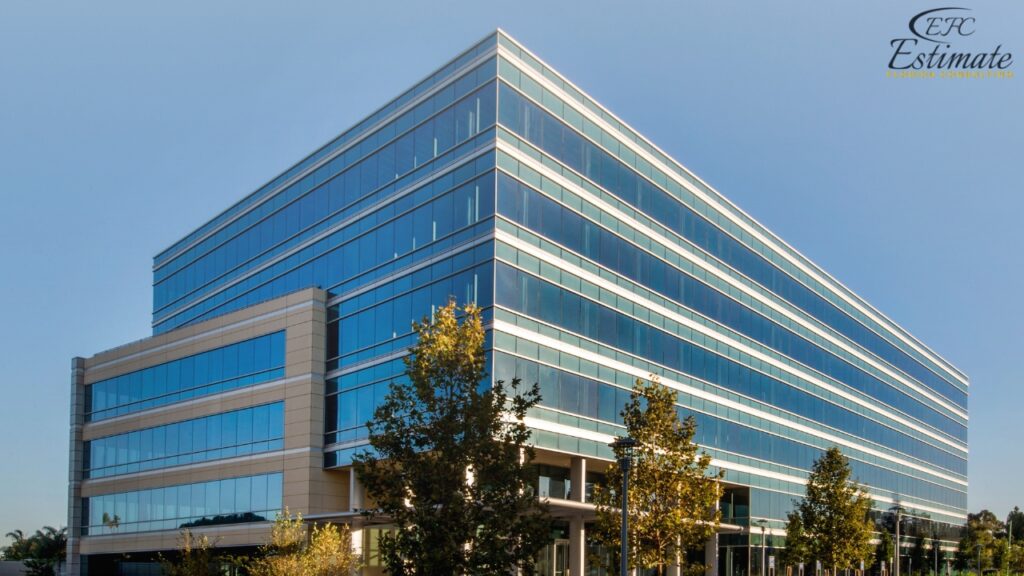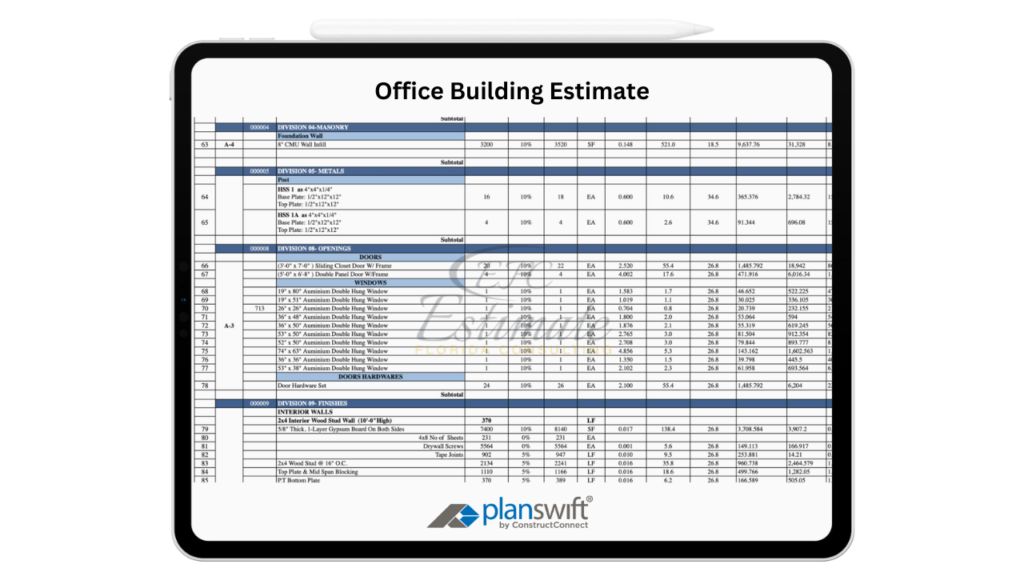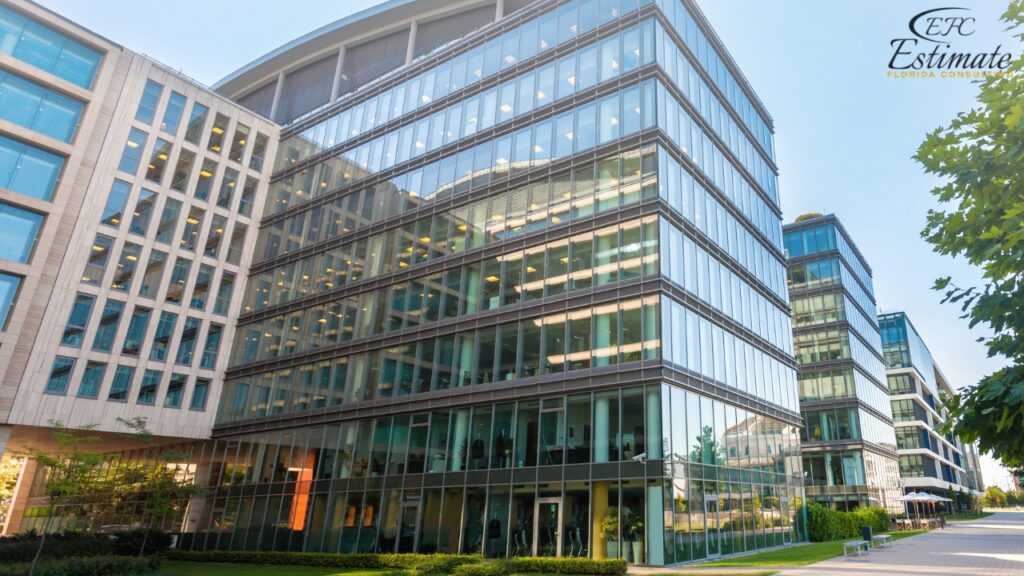Average Cost to Build a Commercial Office Space per Square Foot
Location is one of the biggest factors affecting the cost of commercial buildings. For smaller installations, the median construction cost is around $455 per square foot. In areas like Florida, this can go up to $585 per square foot. Here’s a table showing the adjusted cost ranges for different types of commercial buildings:
Building Type | Cost per Square Foot |
Single story office | $376 – $568 |
Mid-rise office | $429 – $1131 |
High-rise office | $559 – $1301 |
Government administrative buildings | $554 – $1097 |
Museum/ performing arts | $845 – $1654 |
Medical office buildings | $586 – $1323 |
Recreation/ gymnasiums | $451 – $888 |
Single-Story Office Building
For single-story commercial office spaces, costs are influenced by the size of the project, quality of finishes, and the complexity of the design. Simple office designs tend to be more affordable, while customized features, advanced HVAC systems, or high-end finishes can increase expenses. Location also plays a significant role, with urban areas often seeing higher construction costs due to labor and material prices.
Mid-Rise Office Building (4-8 Stories)
Mid-rise office buildings, typically between 4 to 8 stories, require more intricate infrastructure, including elevators, fireproofing, and enhanced HVAC systems. The need for structural support for multiple floors adds to the complexity of the construction. Building codes and safety requirements, especially in densely populated areas, can also impact costs.
High-Rise Office Building (9+ Stories)
High-rise office buildings involve advanced structural systems to support multiple floors, along with sophisticated electrical, mechanical, and safety features. Elevators, fireproofing, and emergency systems must be more robust, driving up the cost. Urban locations with dense populations usually see higher costs due to regulations, labor, and premium material choices.
Get Acquainted with Commercial Office Spaces
Government Administrative Buildings
Government administrative buildings are built with a focus on durability and long-term functionality. These structures often have to comply with stringent regulations and may incorporate security and specialized office spaces. The longevity of materials and efficient space utilization are critical factors that influence construction costs.
Museums and Performing Arts Centers
Museums and performing arts buildings are specialized projects that often involve unique architectural designs, complex lighting and acoustic systems, and spaces designed to accommodate large crowds or exhibits. The cost depends heavily on the custom features, the level of artistic detail, and the technology integrated into the building.
Medical Office Buildings
Medical office buildings are designed to meet strict health and safety standards. These spaces typically include exam rooms, labs, and patient care areas, which require specialized finishes and equipment. The complexity of designing spaces that meet healthcare regulations and incorporate medical technology is a significant factor influencing construction costs.
Recreation Centers and Gymnasiums
Recreation centers and gymnasiums are typically designed with open floor plans, sports flooring, and locker room facilities. The design complexity varies depending on the type of sports and recreational activities the building will support. The cost is impacted by the specific features, equipment, and large indoor spaces needed for fitness and recreational use.
Commercial Construction Costs Per Square Foot by Building Type in Florida
Construction costs in Florida can vary significantly based on the type of building and local market conditions. Below are average estimates for various building types across Florida.
Commercial Office Buildings
The average construction cost for a single-story office building is approximately $407 per square foot. This figure reflects basic design elements and finishes that meet local standards. Mid-rise office buildings, often featuring more sophisticated designs and amenities, average around $731 per square foot. High-rise buildings, which typically include advanced structural engineering and high-quality materials, tend to cost about $858 per square foot.

Additional factors influencing these costs include location within urban centers such as Miami or Orlando, the demand for energy-efficient systems, and Florida’s specific building codes that may require features to withstand hurricanes and severe weather conditions.
Hospitality/Lodging
Costs for hotels and lodging facilities in Florida vary widely by location, construction standards, and the level of amenities provided. A three-star hotel typically costs around $622 per square foot, incorporating standard finishes and basic amenities. In contrast, a five-star hotel, known for luxury finishes and comprehensive guest services, averages about $898 per square foot. The choice of materials, including high-end fixtures and furnishings, along with compliance with hospitality regulations, significantly affects these costs. Additionally, the hotel’s branding and market positioning play a crucial role in determining the level of investment required for construction, especially in high-demand tourist areas such as Orlando and Miami.
Warehouses and Manufacturing Facilities
Construction costs for warehouses and manufacturing facilities in Florida can differ greatly depending on the specific use and design. The average cost for a regional distribution warehouse is about $278 per square foot, reflecting a functional design tailored for storage and logistics. A light industrial warehouse, designed for more specialized operations, is more expensive at approximately $309 per square foot. Technology laboratories, which require advanced infrastructure to accommodate specialized equipment and safety features, are the priciest, averaging around $826 per square foot. Factors such as climate control needs, local regulations regarding industrial zoning, and the availability of skilled labor further influence the overall costs.
Healthcare Facilities
Healthcare facilities are essential in Florida’s growing cities, with frequent new constructions aimed at meeting population needs. Acute care facilities are the most expensive, costing around $1,326 per square foot due to the complex requirements for patient care, advanced medical technology, and regulatory compliance. Medical office buildings, which offer outpatient services, average about $648 per square foot, while specialty clinics typically cost around $805 per square foot. The high costs associated with healthcare facilities are often driven by the need for robust infrastructure, such as plumbing and electrical systems that can support advanced medical equipment, as well as strict adherence to state and federal health and safety regulations.
Schools and Universities
Education facilities are foundational to Florida’s communities, requiring thoughtful design and construction to foster effective learning environments. The average cost for constructing primary and secondary schools is approximately $425 per square foot, with elementary, middle, and high schools averaging $384, $422, and $466, respectively. This cost includes considerations for classroom size, technology integration, and safety features. In contrast, higher education facilities are generally more costly: standard classroom buildings average around $754, while laboratory buildings, which require specialized equipment and safety measures, cost about $983 per square foot. University buildings average $775 per square foot, and dormitories are the least expensive at around $418 per square foot. The increasing demand for modern educational spaces, including collaborative learning environments and sustainable design elements, further influences these costs.
Retail
Retail shopping centers in Florida are categorized into neighborhood strip centers and regional malls, both of which are sizable and relatively costly to construct. The average cost of a neighborhood strip center is about $482 per square foot, incorporating storefront designs and parking considerations. A regional mall, which includes extensive retail space, food courts, and entertainment options, averages around $698 per square foot. The costs for retail construction are affected by factors such as location, local market demand, and the need for high-quality finishes to attract tenants and customers.

Additionally, the incorporation of sustainable building practices and technologies can lead to higher upfront costs but may result in long-term operational savings.
Parking Structures
Compared to other commercial buildings, parking structures are the least expensive to construct in Florida due to their functional design. An underground multi-level parking structure costs about $186 per square foot, requiring significant excavation and structural support. In contrast, above-ground parking lots average around $92 per square foot, benefitting from simpler designs and lower material costs. However, costs can escalate based on the location, as urban areas such as Miami and Orlando often face higher construction costs due to land scarcity and zoning regulations. Additionally, the need for enhanced security features, such as surveillance systems and lighting, can influence overall expenses.
Public and Community Facilities
Public and community facilities in Florida rank among the most expensive structures to build, as they cater to large populations and diverse needs. Gymnasiums and recreational centers cost around $524 per square foot, designed to accommodate a variety of community activities and events. Government administration buildings average about $768 per square foot, reflecting their functional design and the necessity for durable materials. Police stations typically cost approximately $754 per square foot, requiring secure designs that incorporate specialized facilities. The most expensive public buildings are performing arts centers and museums, averaging around $1,159 per square foot. These structures often feature intricate architectural designs, advanced acoustic systems, and specialized climate control for preserving exhibits, contributing to their higher construction costs.
Commercial Construction Cost Breakdown
When it comes to pricing a commercial construction project, numerous factors come into play. Each aspect contributes differently to the overall cost, so understanding these components is essential for accurate budgeting. Here’s a closer look at the breakdown of commercial construction costs.
Foundations
The foundation is a critical element of any construction project, and it typically accounts for about 11.3% of the total construction costs, according to the Estimate Florida Consulting. This expense includes several key processes: excavation to prepare the site, concrete fills for structural support, backfilling to stabilize the foundation, and, when necessary, retaining walls to prevent soil erosion or shifting.
Labor
Labor costs can vary significantly, representing anywhere from 20% to 40% of the total construction expenses. These costs include both direct and indirect expenses. Direct costs are straightforward, covering employee wages for the workers on the site. Indirect costs, however, are more complex; they encompass employee benefits, taxes, training, and development. Additionally, labor costs can fluctuate based on the labor burden, which considers factors like worker availability and market demand for skilled tradespeople.
Materials
Material costs are heavily influenced by the specifications outlined by the design team. For instance, buildings constructed with steel, which requires more fabrication, tend to be pricier than traditional concrete structures. Overall, material costs typically range from 17.3% to 25% of the total project expenses. Factors such as market fluctuations and the availability of materials in a specific region can also impact these costs.
Region
The location of a project can have a significant effect on construction costs. While there’s anecdotal evidence that zoning regulations can influence pricing, these changes can be inconsistent and hard to predict. For instance, accessibility to materials is often easier in suburban areas compared to highly populated cities. As a result, projects in urban centers like New York City can be nearly twice as expensive as those in midwestern towns, largely due to the higher costs of labor and materials in densely populated areas.
90% More Chances to Win Projects With Our Estimate!
- Multi-Family Building
- Hotel Building
- Hospital Building
- Warehouse Building
- School & University Building
- High-Rise Building
- Shopping Complex
- Data Center Building

Finishes and Fixtures
Finishes and fixtures can significantly elevate overall project costs. High-quality finishes typically command much higher prices than standard or mid-range options. Exterior finishes, which include essential components like walls, roofing, and windows, account for about 15% of the construction costs. Interior finishes—covering insulation, flooring, cabinetry, countertops, lighting, and appliances—are even more substantial, consuming about 29.1% of the total budget. The choice of finish type can dramatically influence this portion of the costs.
Design
Design fees can vary widely based on the complexity of the project. For smaller projects, engineering fees usually fall between 1% and 2.5% of the total costs. However, as projects become larger and more intricate, design fees can climb to anywhere between 4.5% and 16%. These percentages include a contractor markup of 20% to 50%, which can add to the overall expense. Thus, while design fees are crucial, they often represent a smaller portion of the total project budget.
Major Systems/Utilities
Major systems, including electrical installations, plumbing, and HVAC (Heating, Ventilation, and Air Conditioning), contribute to the overall costs, but there is no fixed percentage for these systems due to their variability in scope and complexity. Plumbing usually accounts for around 4.3% of the construction budget, while electrical work is approximately 4.2%. HVAC systems typically comprise 4.4%, bringing the total for these major systems to about 12.9%. For smaller projects, utility costs average around 8.5%.
Permits
The cost of permits varies by city and is influenced by factors such as the type and size of the construction project. Permit fees generally range from 0.5% to 2% of the total project costs. These fees are essential for ensuring compliance with local regulations and building codes, which can impact the overall project timeline.
Landscaping
Landscaping is the final touch on any construction project, typically taking up to 6.8% of the overall budget. This includes not just aesthetic features, but also practical elements like driveways, cleanups, outdoor structures (such as porches), and other enhancements that contribute to the project’s exterior appeal. Proper landscaping can significantly boost the property’s value and functionality, making it a worthy investment within the overall budget.

Other Costs to Consider
When budgeting for a commercial construction project, it’s important to factor in several additional costs that can impact the overall financial picture. Here’s a breakdown of some key areas to keep in mind:
Hard Costs
These are the direct, tangible expenses associated with the construction project. They include essential items like employee benefits, landscaping, site equipment, land leveling, LEED certification (for sustainable building practices), employee training, and the concrete foundation. Understanding these costs is crucial, as they form the backbone of your project budget.
Soft Costs
Soft costs are indirect expenses that may not be immediately visible but are equally important. This category includes taxes, contracts, legal fees, architectural design services, and insurance. These costs can add up quickly, so it’s wise to account for them during the planning phase.
Long-Term Costs
Once the construction is complete, there are ongoing expenses to consider. Long-term costs encompass maintenance, daily operational expenses, utility bills, and energy costs. These factors can significantly affect your bottom line, so it’s essential to plan for them in your budget.
Financing Costs
If you’re taking out loans to finance the project, it’s crucial to include financing costs in your overall budget. Interest rates and loan terms can impact your expenses over time, so understanding these costs upfront will help you manage your financial commitments effectively.
Estimating Commercial Building Costs
Estimating construction costs for commercial buildings can be complex, as they can vary significantly from project to project and across different locations. Several key factors play a crucial role in determining these costs, including the quality of the building, design and architecture, materials, labor costs, permits, mechanical and electrical systems, and finishes.
The first step in creating a construction estimate is to classify the building. Commercial buildings are typically categorized into classes A, B, and C, with Class A representing the highest quality. Once the building class is established, the next step is to calculate the floor area based on the structural design and architectural plans. It’s important to note that more intricate architectural designs generally lead to higher construction costs per square foot.
After determining the cost per square foot, you can multiply it by the total floor area to arrive at an initial estimate. However, labor costs must also be factored in, as these can vary widely depending on the project’s location. For example, labor costs can differ by 2% to 6% between urban and suburban areas, so it’s essential to calculate these costs and add them to your previous estimates.
Material expenses are another critical component of the overall cost. Large commercial buildings or those with complex steel frameworks tend to have higher material costs due to the quantity and type of materials required. Additionally, you’ll need to consider permit fees, which can vary based on the project’s location and scope, as well as the costs associated with finishes, which can range widely depending on the quality and style chosen.
While there isn’t a one-size-fits-all approach to estimating commercial building costs, having a solid understanding of these variables will help you arrive at more accurate estimates and guide your design decisions effectively.
Download Template For Office Building Project Breakdown
- Materials list updated to the zip code
- Fast delivery
- Data base of general contractors and sub-contractors
- Local estimators

Conclusion
Estimating the average cost to build a commercial office space involves numerous variables, including location, building type, and design complexity. In Florida, costs can range significantly, with single-story offices averaging around $407 per square foot, while high-rise buildings can reach $858. Each building type, from warehouses to healthcare facilities, has its own cost structure influenced by local market conditions and construction standards. By understanding the various components of construction costs—such as labor, materials, and permits—developers can create more accurate budgets and ultimately ensure successful project outcomes.
FAQs
The overall cost to paint a 2,000-square-foot house exterior typically ranges from approximately $5,040 to $18,200. This estimate includes materials, labor, and preparation work necessary for a high-quality finish. Factors such as geographic location, local cost of living, and availability of skilled labor can cause this range to fluctuate. In metropolitan areas, prices may be higher than in rural settings due to demand and the cost of doing business.
Several key factors affect the overall cost:
- Type of Paint: Higher-quality paints offer better coverage and durability, but they also come at a premium price. Standard latex, premium latex, and high-end acrylic paints range from approximately $57.60 to $291.20 per gallon.
- Surface Preparation: Proper preparation is vital for a long-lasting finish. Tasks like power washing, scraping, and repairs can add significant costs. Preparation can range from $0.58 to $8.73 per square foot depending on the work needed.
- Labor Costs: Labor costs vary based on location and painter experience, averaging between $73.60 and $217.60 per hour. The total labor cost for a 2,000-square-foot house can range from $8,740 to $17,460.
- Accessibility and Complexity: Homes with multiple stories, intricate designs, or hard-to-reach areas may incur higher labor costs. Factors like height, architectural features, and siding material all impact accessibility and, subsequently, cost.
Most paint jobs require at least two coats for optimal coverage and durability, which can double your paint costs. Darker colors may require additional coats to achieve the desired richness and depth.
Weather can significantly influence both the timing and quality of your paint job. Extreme temperatures, humidity, or rain can impact drying times and may lead to additional labor costs if your project is delayed due to inclement weather. It’s generally recommended to paint during mild weather for the best results.
Scheduling during peak seasons (spring and summer) may lead to higher costs due to increased demand for professional services. Conversely, off-peak seasons (late fall and winter) may yield discounts and better availability of skilled painters. Flexibility with timing can help save on costs and provide a more personalized service experience.
Selecting a qualified contractor is crucial. Research potential contractors by reading reviews, asking for recommendations, and obtaining multiple quotes. Ensure you ask about their experience, the materials they use, and warranty policies. A trustworthy contractor will provide a detailed estimate outlining all costs involved.
In addition to paint, labor, and preparation, consider costs for items like scaffolding, extra paint for touch-ups, and any unexpected repairs that may arise during preparation. Always budget for unexpected expenses to ensure you’re financially prepared for the project.
Google Reviews



Process To Get to Build a Commercial Office Space per Square Foot Estimate Report
Here I am going to share some steps to get to build a commercial office space per square foot estimate report.
-
You need to send your plan to us.
You can send us your plan on info@estimatorflorida.com
-
You receive a quote for your project.
Before starting your project, we send you a quote for your service. That quote will have detailed information about your project. Here you will get information about the size, difficulty, complexity and bid date when determining pricing.
-
Get Estimate Report
Our team will takeoff and estimate your project. When we deliver you’ll receive a PDF and an Excel file of your estimate. We can also offer construction lead generation services for the jobs you’d like to pursue further.

